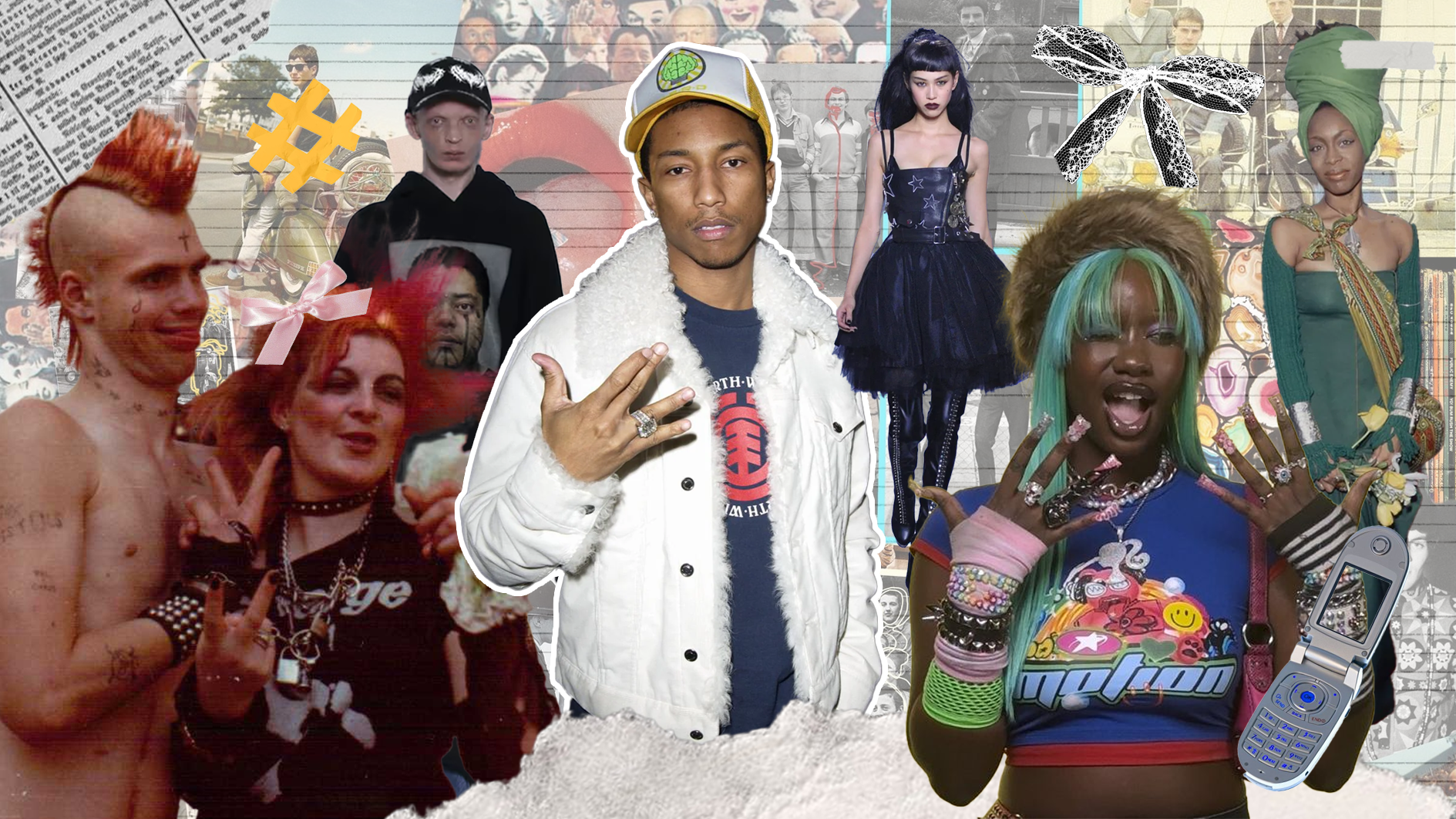The Fading Underground: The Decline of Subculture in the 21st Century
Cultural expression is transforming as once-vibrant subcultures like punk, goth, and rave are fading due to mass media and digital connectivity.
In the 21st century, the landscape of cultural expression is undergoing a profound transformation, marked by the gradual disappearance of once-vibrant subcultures that defined previous decades. The underground scenes that flourished in the late 20th century—punk, goth, rave, and others—seem to be fading into obscurity, overshadowed by the homogenising forces of mass media, globalisation, and digital connectivity. The signs of subcultural erosion are evident, prompting us to ponder the significance of this cultural shift and its impact on individual identity and collective diversity.
So, what does subculture look like in 2024? Is it the digital culture around bows and girlhood, as captured by Sandy Liang, or more classic examples like punks in Camden wearing battle vests and Dr. Martens in the late 1970s? Perhaps it's a blend of both. Either way, there's an increasingly significant relationship between subcultures and alternative or niche Aesthetics driven by young people. Yes, we are losing subculture, and the internet is a significant factor in this shift.
Subcultures are increasingly distilled into mere aesthetics, stripped of their deeper cultural and ideological significance. Reductionism has meant that these rich, vibrant communities are transformed into easily consumable Pinterest boards focused solely on appearance. The essence of subcultures historically represented profound social and political statements but now are often overshadowed by the superficial need to fit the part visually. This trend is evident in how people curate their Instagram feeds, emphasising the look over the lifestyle and values these subcultures once embodied.
This superficiality breeds constant debates about what truly constitutes membership in these communities. For example, the punk scene and emo subcultures were originally rooted in a rejection of mainstream norms and a commitment to authenticity.
However, in today's current social media-driven landscape, these movements are frequently reduced to mere fashion choices devoid of their original rebellious spirit. The commodification of subcultures diminishes their historical and cultural significance and fosters a sense of inauthenticity among participants. What was once a profound expression of identity and values is now a checklist of visual markers to be displayed online.
An "aesthetic" is what happens when capitalism gets to a subculture. Take Goth or Punk, for example, prolific subcultures with a deep, rich history of countercultural movements that are about DIY and thrifting and being anti-capitalist and anti-consumerism. It wasn’t simply dressing in punk or goth; you had to be punk or goth through and through.
This meant immersing yourself in the music, actively participating in the community, and genuinely believing in the ideology. However, with the rise of fast fashion companies like Shein, which fundamentally oppose the anti-consumerist values of these subcultures, they are now selling "punk" and "goth" clothes. This creates a disconnect where people justify their purchases by claiming that Shein is the only place to find punk clothes that are completely detached from what the subculture truly represents. They see it merely as an aesthetic.
“Young people today don’t identify with music in the same way teenagers from the 1940s to the 1990s did. Their main influence used to come from art and musical movements because those were the teenage forms of expression, but not anymore. Teenagers still listen to music—they go clubbing more than ever—but the music doesn’t play the same role in their lives as it used to in ours [the late 1980s]. That role has been filled be video games, social media, film franchises.”
The reason aesthetics exist is simply to sell you things, stripping subcultures down to their shallowest, most basic elements and repackaging them, making it easier to sell trendy items.
Aesthetics have expanded beyond fashion into how we decorate our homes, live our lives, and even the foods and drinks we consume. This is how fast fashion brands sell a lifestyle. Shein models adorned in Coquette outfits in Coquette-themed rooms, selling the idea that buying a Coquette skirt will transform you into the idealised version of yourself. However, upon purchase, you find that you haven't transformed; you're still the same person with just another skirt in your closet. This is the essence of marketing: convincing you that an aesthetic will change your life, even though it's just another way to sell you more products.
When TikTok first began significantly influencing fashion in 2020, publications were quick to label the app's niche aesthetic trends as subcultures. This might be because early TikTok aesthetics like “Cottagecore” and “Earthy” which seemed to offer a more encompassing lifestyle and community beyond just fashion. Trends such as these spoke more to the historical definition of subculture, rooted in elements deeper than aesthetics—such as shared values, social and political ideas, community, and artistic practices like music.
From fashion to hair, appearance has traditionally been a way to signal belonging to a subcultural group and reflect its values visually. Despite that, many recent internet-driven aesthetics seem to hyper-focus on style above everything else, leaving us with influential trends that remix subcultural symbols but lack the deeper meaning of subculture. Platforms like Instagram, TikTok, and Pinterest have facilitated the rise of micro-aesthetics that remix subcultural symbols but often sideline their original context and meaning.
This phenomenon leaves us with influential trends that prioritise visual appeal over the deeper, often radical, ideologies that once underpinned these styles. Movements like "cottagecore," "dark academia," and "e-girl" are heavily driven by their visual components. These aesthetics borrow elements from historical, literary, and subcultural sources, reassembling them into cohesive, marketable looks with a greater focus primarily on creating an Instagram-worthy image rather than engaging with the underlying cultural or ideological narratives.
The rapid commercialisation of these aesthetics exacerbates the issue. Fast fashion brands and lifestyle companies quickly capitalise on these trends, producing and marketing items that fit the aesthetic mould. This commercialisation often dilutes the original meanings and values, reducing them to easily consumable and disposable products.
For example, the punk aesthetic's anti-consumerist roots are contradicted by its adoption by fast fashion brands that thrive on mass production and consumption. Traditional subcultures were often tightly-knit communities united by shared values and mutual support. While fostering large online followings, internet-driven aesthetics lack the same sense of community and authenticity. The focus is on individual expression through curated images rather than collective identity.
For example, Grungecore references the grunge subculture of the 90s in its name but does not incorporate the subculture's original ethos. Emerging from the Pacific Northwest, particularly Seattle, Grunge was characterised by its anti-establishment attitude, a rejection of consumerism, and a raw, unpolished aesthetic. It was not just about fashion but a deeper expression of disillusionment with mainstream culture and a desire for authenticity in music and lifestyle.
Grungecore, in contrast, often reduces this rich, complex subculture to a mere fashion statement. While it borrows elements of the grunge look—such as flannel shirts, distressed jeans, and combat boots—it lacks the underlying spirit that defined the original movement. The essence of grunge was its DIY ethos, its connection to the local music scene, and its anti-commercial stance elements largely absent in the grungecore trend.
The hippie subculture of the 1960s, originally a countercultural movement that rejected mainstream norms and championed peace, love, and freedom, has now been transformed into the widely popular boho aesthetic. The original hippies were known for their anti-establishment values, communal living, and opposition to the Vietnam War, as well as their exploration of alternative lifestyles and spirituality and not to forget the iconic Woodstock Festival. Fashion characterised by tie-dye clothing, bell-bottom jeans, flowing dresses, and eclectic accessories was a visual manifestation of their ideologies and a rebellion against societal norms.
However, the modern boho aesthetic, while drawing heavily from the visual elements of hippie fashion, again lacks the ideological underpinnings that defined the original movement. Major fashion brands and retailers capitalising on its carefree, eclectic style has led to the commercialisation of what was once a "subset of society". A shift from hippie to boho represents a broader trend of detaching style from substance, diluting the power of the symbols and styles that once stood for important societal changes and values.
A new point of concern is the impact of this transformation on the formation of identity and individuality in contemporary society. As individuals navigate a digital world saturated with curated images and commercialised aesthetics, there is a risk that their sense of self becomes increasingly defined by external, superficial markers rather than internal values and convictions.
The lines between authentic self-expression and performative display then become blurred. The constant pressure to conform to the latest aesthetic trends can stifle creativity and individualism, leading to a homogenised cultural landscape devoid of the diverse voices that subcultures historically provided.
While it is evident that how we define subculture may have changed or completely collapsed, there are still glimpses of hope and individuals fostering community through fashion, music and ideology. Among these was the 'Aliyahcore' a trend created by Georgia-based teenager Aliyah Bah. Known for her distinctive style featuring fishnets, moon boots, and fluffy accessories, Bah's invention of Aliyahcore went viral.
At just 20 years old, she emerged as a pioneering voice for alternative Black girls, reopening the gates for subculture and bringing a sense of camp to a global audience. Through her innovative aesthetic, Bah not only garnered widespread attention but also revitalised the essence of subculture in an impactful way through her own music, industry cosigns and the community she has created online.


